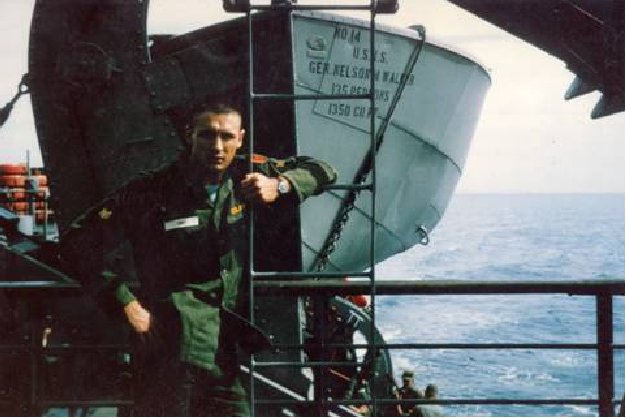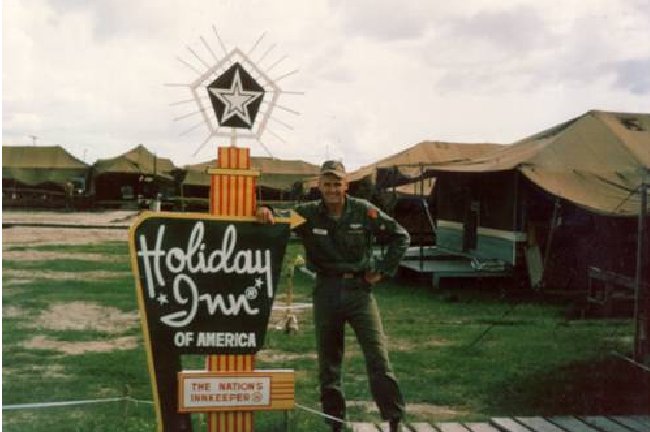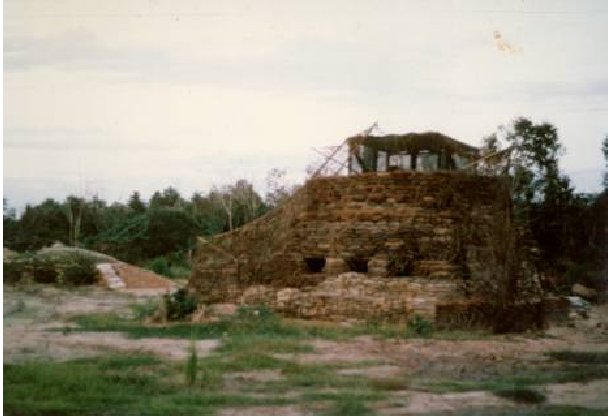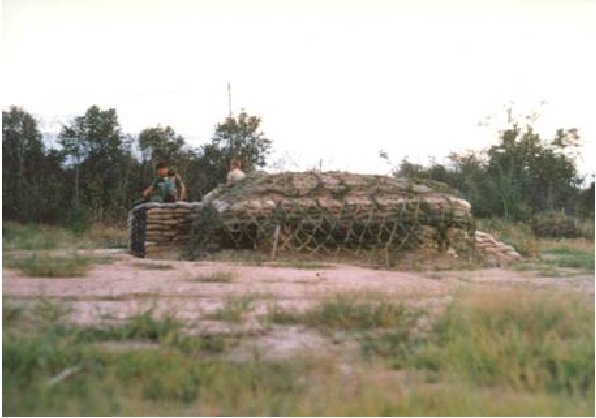
This is a bit more background on how the two divisions were first alerted and arrived in Vietnam.
During the latter part of 1965, the 25th Division was alerted to deploy to Vietnam. - Sarge AK
From (courtesy of ) Ev Stoutner:
I took command of the 3rd Brigade in June, 1965. At that time the major units of the Brigade
were: 1st Bn, 35th Infantry commanded by Lt. Col. Ed Callanan, 2nd Bn, 35th Infantry
commanded by Lt. Col. George Scott (now deceased), 1st Bn, 5th Mech Inf commanded by Lt.
Col. Thomas Greer, 2d Bn 9th Artillery commanded by Lt Col Saul Jackson.
On December 12, 1965 I was directed by Col Tom Mellon, 25th Inf Div C/S to meet Major General
Fred Weyand , CG 25th Infantry Division, at his quarters at 1800 hours that evening. Gen Weyand,
who had just returned from a meeting at CINCPAC, informed me that the 3rd BDE was to be
deployed to Pleiku, Vietnam and that an Advanced Party should leave within a week. This
information was, of course, TOP SECRET at that time.
The 3rd Brigade was tailored as a Separate Brigade Task Force and would be under the
Operational Control of the CG First Field Force Commanded by Maj Gen Stanley Larsen whose
Headquarters was some 100 miles Southeast of Pleiku on the Coast at Nha Trang .
Before leaving Schofield Barracks, the 1st Bn 5th Mech was moved to the 2nd Brigade and the
1st Bn, 14th Infantry commanded by Lt Col Gilbert Proctor was assigned to the 3rd Bde. In
addition to the three infantry battalions, and the direct support artillery battalion, there was a
Provisional Support Battalion, consisting of various combat and service support elements such
as Medical, Signal, Ordnance, and Administrative units . Plus, there was a combat engineer
company, a cavalry troop and a tank company. The overall strength of this separate brigade task
force was about 4200 people.
The 3rd Bde, less the 1/14 and the large armor and engineer equipment, deployed by air. The
code name of the airlift was "Operation Blue Light". The Air Force dedicated 12 C-141 and 4 C -
133 aircraft to this operation. The Advance Party, utilizing three C-141 aircraft, departed for
Pleiku on or about December 16th. (I do not recall the exact date) The Main Body started
deployment on December 25th and I departed Schofield Barracks at that time. Major (P) Phil Feir,
was the Brigade Executive Officer. He remained at Schofield to supervise the movement and to
close out the brigade responsibilities as the last elements of the brigade departed.
The 1/14th Inf, after spending 12 days at sea, arrived at Cam Ran Bay on January 17th, 1966. Our
initial mission was to build a Base Camp about 4 miles East of Pleiku, establish communications,
and to ensure the protection of the base as the units phased in. A plane arrived about every six
hours. In addition, we had the mission of securing Hwy 19 (?) from the Coast to Pleiku as our out
sized and logistical elements moved via that route to Pleiku.
As I recall, the 3rd BDE completed its move to Pleiku during the 3rd week in January 1966 which
was eight days ahead of the target date that had been set by MACV.
Operation Blue Light was completed without incident and was, at that time, the largest Air
Force/Army movement in point of number troops moved and the amount of ton miles flown. The
61st Military Air Lift Wing flew 225 missions, transporting more than 4700 Tons of cargo plus
approximately 4000 troops. A total of 225 missions were flown during this movement.
Following this early movement of the brigade, the 1st Battalion, 69th Armor joined the unit in
May 1966. The brigade engaged North Vietnam regulars along the Cambodian border and then
Viet Cong main-line forces in Quang Ngai province for which it received a Valorous Unit Award.

4th Division
The 4th Division started it's deployment on July 21, 1966 as the USS Nelson M Walker departed
the Port of Tacoma and arrived in Qui Nhon on August 6, 1966 to deploy it's 2nd Brigade (1/12th,
3/12th, 2/8th) to the Central Highlands near Pleiku. Two months later on October 4th, the 1st
Brigade (1/8th, 3/8th, 1/22nd) arrived in Vietnam and right behind them on October 12th, the 3rd
Brigade (2/12th, 2/22nd, 3/22nd) arrived at Vung Tau, Vietnam."
"For some reason and I am guessing, with the ramp up of the war and as we began to
deploy divisions to Vietnam, MACV was feeling their way along. We just located the 25th
Div's 3rd brigade to the north and their 2nd Brigade to Cu Chi. Just prior to this the 4th
staged two brigades to I Corp so when the 3rd Brigade of the 4th arrived they were not
needed in the north immediately so they were moved from Vung Tau inland as a staging
maneuver. With the 25th Division setting up it's headquarters in Cu Chi and already manned
with two brigades, the plan seemed to be to also expand the presence of the fighting forces
toward War Zone C and D which meant establishing a presence in Dau Tieng which
Operation Fort Nisqually initiated in November, 1966. The 2/12th Inf. was part of the 3rd
Brigade, 4th Infantry Division who were Hq'd in Central Vietnam. But due to where they
were currently located in III Corp, the 3rd Brigade (and the 2/12th ) was placed under the
operational control of the 25th Infantry Division's HQ and visa versa for the 25th's 3rd
Brigade located in Pleiku. Ultimately, in August of 1967, the two divisions reflagged their
respective brigades and realigned the division. " - Sarge AK
On November 28, 1966, the 3rd Brigade of the 4th Infantry Division established a base at Dau
Tieng via Operation Fort Nisqually. The 3rd Brigade began continuous operations in the area
surrounding Dau Tieng with maximum use of small unit patrols and "Bushmasters". Once the
surrounding area was secure, the Brigade joined other units of the 25th Division in field operations.
In April 1967 the 196th was transferred to Chu Lai in I Corps, thus reducing the division to three
brigades. On 1 August 1967 the 25th Division assumed control of the former elements of the 3rd
Brigade, 4th Division, the 2nd Battalion, 12th Infantry, 2nd Battalion (Mechanized), 22nd Infantry
and the 3rd Battalion, 22nd Infantry. The 2nd Battalion, 77th Artillery was assigned to the 25th
Division Artillery. In exchange the 4th Division at Pleiku assumed control of the units formally with
the 25th Division's 3rd Brigade, 1/14th, 1/35 & 2/35th Infantry except for Troop C, 3/4th Cavalry
and several other company-level support elements which rejoined the division at Cu Chi less
personnel and equipment.
On January 27, 1966, at 0830 hours, Task Force Queen, consisting of the 1st Bn 27th Infantry,
the 2nd Bn 27th Infantry, the 1st Bn 8th Artillery(-), the 2nd Brigade Headquarters and
Headquarters Company (-), and elements of the 2nd Support Bn, proceeded from the staging area
near Saigon University to Cu Chi.
On January 29, 1966, at 0830, hours Task Force King, consisting of the 1st Bn(M) 5th Infantry(-),
The 2nd Brigade HHC Rear element, and elements of the 2nd Support Bn began movement to their
assigned assembly area at Cu Chi from the staging area near Saigon University. Meanwhile at
0700 hours, the 1st Bn 27th Infantry began relieving the 1st Bn 28th Infantry, 1st Infantry Division
and assumed their perimeter defensive positions. They also provided extraction zone security for
the 1st Bn 28th Infantry.
At 1200 hours, the 2nd Bn 27th Infantry began relieving Company B, 2nd Bn 2nd Infantry, 1st
Infantry Division and assumed their perimeter defensive sector. A secure extraction zone was also
provided for Company B, 2nd Bn 2nd Infantry.
On February 3, 1966 the last element of the 2nd Brigade Task Force closed into the Cu Chi base
camp area from the staging area near Saigon University. There were no major convoy incidents
during the movement of the entire task force.
On February 22, 1966, Troop A, 3rd Squadron, 4th Cavalry arrived at the Cu Chi Base Camp
Area.
Last to arrive was the 1st Brigade (4/23rd) on 29 April 1966. Before leaving Hawaii the brigade
received two battalions from Alaska, the 4th Battalions of the 9th and 23rd Infantry to bring it up to
strength. During the period from the summer of 1966 to the spring of 1967 the 25th Division was
the largest division in Vietnam with four brigades under its command, the division s 1st and 2nd
Brigades as well as the 3rd Brigade, 4th Division and the 196th Light Infantry Brigade. In early
1967 the 25th participated in two major operations conducted in Military Region III, Cedar Falls and
Junction City.
April, 1966 - The 25th's 1st Brigade leaves Hawaii in April by ship and arrives in Vung Tau on April
29, 1966 and the next day, is airlifted to Cu Chi where she joins the rest of the division.
On January 22, 1966 an Operations Order was issued to alert units to prepare to move to the area of Cu
Chi. Movement was to be in 4 segments. The first segment on January 25; the second on January 27;
the third on January 29 and the fourth at a date to be determined.
The 1st Infantry Division (Reinf) was given the assignment of receiving, staging and deploying the 2nd
Brigade 25th Infantry Division to the base area near Cu Chi. The 1st Division was to coordinate security
during movement to, initial occupation of, and development of the Cu Chi base camp area.
The 3rd Brigade, 1st Infantry Division was assigned to clear and secure the initial base area near Cu Chi
not later than 1200 hrs on January 25, 1966. The 25th Infantry Division of the Army of the Republic of
South Viet Nam (ARVN) was assigned to secure Highway 1 from the area of the Cau Bong Bridge to the
road junction of Highway 8A near Cu Chi during the movement of the 2nd Brigade Task Force convoys.
On January 25, 1966 at 0930 hours, Task Force Jack, consisting of one company from the 1st Bn(M)
5th Infantry , one battery from the 1st Bn 8th Artillery, Companies B and C of the 65th Engineer Battalion
and the advance parties from 2nd Brigade units departed the staging area near Saigon University and
proceeded to an assigned assembly area at Cu Chi. After the arrival of TF Jack at Cu Chi, elements of
the 1st Infantry Division continued to receive small arms (SA), automatic weapons (AW) and mortar fire.
The Viet Cong (VC) in the area were operating in small teams and attempted to maintain continual
harassing activities against friendly forces.
TF Jack units were moved into assembly areas in the vicinity of their assigned sectors. The 3rd Brigade
of the 1st Infantry Division was responsible for the security and defense of the area and orders were
issued that strict fire discipline was to be observed by all units. The firing of weapons by TF Jack units
was not permitted during the period that the 3rd Brigade, 1st Infantry Division had responsibility for
security of the area.
From the 1/5th Bobcat's (courtesy of) website:
"The main body of the 2nd Brigade Task Force, 25th Infantry Division, arrived at Vung Tau, South Viet
Nam on January 18, 1966. The 2nd Brigade Command Post was initially located in the area of Saigon
University. Company B, 1st Bn 503 Bde, 173rd Abn Div was under the operational control of the 2nd
Brigade Task Force and supplied the perimeter security for the Task Force. The 2nd Bn 27th Infantry
supplied 9 rifle squads to Co B, 1/503rd Inf to reinforce the perimeter security of the staging area. The
1st Bn 27th Infantry and the 1st Bn (M) 5th Infantry were on standby to furnish 3 rifle squads each to
Co B, 1/503 rd Infantry, should they be needed. Controlled issue of ammunition for the 2nd Brigade
Task Force was to be maintained. Only those personnel occupying perimeter defensive positions and
ambush sites were supposed to be issued ammunition.

|

|

|

|

|

|
| Aboard USS Walker |
3rd Bde at Cam Ranh Bay '66 |
At Cu Chi |
Command Bunker 1/5th |
Bunker 1/5th at Cu Chi |
Tower with 90MM 1/5th |
These photos were emailed to me, but so far, I haven't identified the contributor







